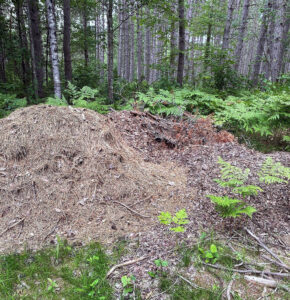Erika Segerson-Mueller, DNR Invasive Plant Program Specialist, Oshkosh Service Center Erika.SegersonMueller@wisconsin.gov or 715-492-0391

This garden waste was dumped along an ATV trail in a state forest and can be a pathway for invasive plants and diseases that affect our public lands. / Photo Credit: Wisconsin DNR
When a pile of more than 500 pounds of uncooked pasta was found in the woods in New Jersey in early May, no one was quite sure why or how the piles had appeared — but it was clear that they didn’t belong there.
Whether spaghetti noodles, broken electronics or old furniture, some things shouldn’t be in our woods, waters or roadsides, no matter the reason.
Though it may seem obvious that you should avoid dumping these types of waste in your local woods, some items aren’t as straightforward.
What about green waste, or waste that comes from your garden or yard? While they are biodegradable, grass clippings, leaves, waste soil and other plant materials also don’t belong in the woods for numerous reasons.
Forests support a diverse range of plant and animal life, and additions to these ecosystems can disrupt the balance needed for native species to flourish. Yard debris can include seeds, spores or pests that are not native to the forest environment.
Seeds from ornamental garden plants can take root in forest environments and spread rapidly, quickly turning into an invasive species and crowding out or killing native vegetation. Invasive species are defined under Wisconsin Statute 23.22 as “nonindigenous species whose introduction causes or is likely to cause economic or environmental harm or harm to human health.” An overgrowth of invasives also can leave fewer resources available for native animals who rely on native plants for food.
Once invasive species have been introduced to forests, they can easily spread if uncontrolled and are very difficult to eradicate. If you think you have found invasive species in your woods and want to know why it matters, learn more about the harm invasives can do to economics, health and ecology.
What’s more, yard and garden waste is often treated with chemical fertilizers or herbicides. These may pose a danger to wild plants and can even kill off native species when introduced to forests. Chemical-filled yard waste can also endanger forest animals that attempt to eat the clippings.
Another reason not to dump your clippings in forests: wildfires. Yard waste can be highly flammable, and piles of clippings can increase fire danger in forests.
Instead of endangering native forest plants, trees and creatures by providing a pathway for the potential introduction of invasive plants and increasing fire danger, avoid dumping yard waste in our important forest ecosystems.
There are better options to safely dispose of yard waste. Many communities have yard waste collection days, when your trash removal company or municipality will remove the waste from curbside for you. Many other communities offer a drop-off service for yard waste management. Check with your municipality to find out the specifics of the program nearest you.
Private landscape companies or farms may also take drop-offs of yard waste for composting or landspreading. You can find a list of licensed compost facilities in the state here.
If you prefer to manage yard waste yourself, consider creating a home compost pile or getting a tumbler composter to let material safely decompose away from sensitive natural areas. When the compost is ready, you can re-use it in a garden or around landscaping, reducing waste and enriching your soil. Check out the DNR’s home composting brochure to get started.
